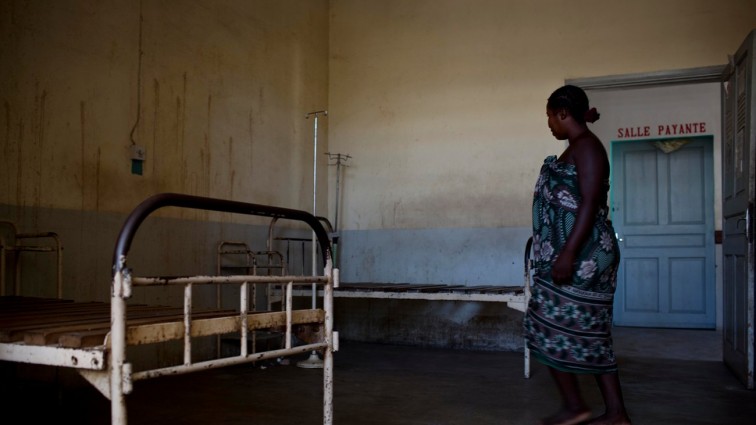Health in Madagascar takes turn for the worse as $22m hospital abandoned

Health in Madagascar takes turn for the worse as $22m hospital abandoned
With water, sanitation and doctors scarce, and facilities deteriorating, Madagascar faces a healthcare crisis. So why does a cutting-edge hospital stand unused?
Inside the glass-fronted reception of the state-of-the-art hospital are rows of upholstered chairs. Not one has yet been sat on. Also unused are the x-ray area, surgical unit, dentistry and child health units, and an array of medical equipment.
The hospital was almost complete, with just the morgue unfinished, when work suddenly stopped in 2012. A large metal fence was erected around the perimeter and a security guard installed to keep the public out.
This $22m (£17m) hospital in Menabe, west Madagascar, was a pet project of former president Marc Ravalomanana, who was ousted in 2009, but the initiative was not continued under President Hery Rajaonarimampianina, despite the dire need for improved health services in the area.
Climate change plagues Madagascar's poor: 'The water rose so fast'
Read more
Francis Andriamiariosa, the regional director of public health, says staff had already been transferred from other areas to work in the new hospital before it was abandoned. He says government officials came last year to assess the need for the new building and report back to the ministry of health. Since then he has heard nothing.
“All I can do is report my desire for it to be opened to the ministry of health, who in turn report to the president’s office,” he says. “I have requested many times for permission to take use of the equipment, at least. But I can’t do that without authorisation. We really do have an urgent need.”
Morondava referral hospital, the existing district hospital, is next door. Until two months ago the decaying single storey building didn’t even have toilet blocks for most wards. They were installed recently by WaterAid, the NGO. The new toilets also serve as the only public latrines in the surrounding village. For patients they are free; for villagers there is a small fee.
Andriamiariosa says the biggest problem facing the health system is “infrastructure”. “By that I mean water, sanitation, electricity and the condition of staff accommodation and wards. Our second biggest challenge is that we simply do not have enough doctors.
“The central government is responsible for hiring doctors annually – they determine the numbers, not regional officials. But it falls far short of what is needed year upon year. I have 384 medical staff, of whom 63 are qualified doctors. But I need three times as many doctors.”
The wards in the referral hospital paint a depressing picture. On one side of the corridor patients rest in iron beds with only wooden slats for comfort. Patients can use the showers outside. Yet on the opposite side of the corridor are the salles payantes – wards for those who can pay. Freshly painted, the rooms have ensuite showers and beds with mattresses and blankets.
“We don’t have the resources to provide better wards. If patients want a nicer room they have to pay,” says Dr Rovoson Raholy, technical director of the hospital.
Marie Jeanne’s daughter has a stomach infection. “I had to walk here for three hours, carrying her the whole way. When I got here she was very weak and dehydrated. But we had to wait several hours to be seen. Patients who had money were seen before her.”
Lack of safe water and sanitation at health centres is also a major concern.
““It is a huge problem,” says Lovy Rasolofomanana, the country director of WaterAid, which has installed 200 sanitary blocks in health centres and hospitals across Madagascar. “Even at the most basic level of healthcare, doctors need to be able to wash their hands.”
In a village a few miles away, Celine Raharisoa, chief clinician at Behmonga health clinic, says: “When women come to my clinic to give birth either I or my staff have to waste time boiling water from the well. That is time we should be spending diagnosing and caring for patients. It is a constant struggle.”
Andri Ramanantsoa, a project officer for a local NGO, Engineering Consulting Associates, says the problems at the health centre are typical. “The underground water is seasonal so sometimes the well completely dries up. There is no fence around it so local people take water from the well too, which increases the pressure on it.
“We are trying to collaborate with the government by assessing the needs and then trying to find joint solutions. The government needs to provide the water; we can help to provide the sanitation but it is a slow process. We began working on health sanitation in 2008 and it is still an ongoing process,” he says.
The minister for health, Mamy Lalatiana Andriamanarivo, says he is determined to push ahead with ambitious plans for universal free healthcare. “As a doctor I have seen first-hand the impact poverty has on health. I saw patients have basic treatment but refuse further treatment because they couldn’t afford it. That cannot be acceptable.
“For me, poverty is the single biggest factor [in] poor health in this country and one of the biggest blocks to our overall development. I have already started working with other ministries to put plans into place. Changing this is our biggest challenge and my most important task.”
But with Madagasar’s economic woes and political turmoil, change will be challenging.
Политика конфиденциальности | Правила пользования сайтом







